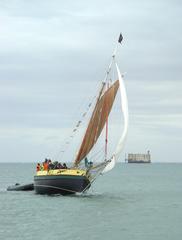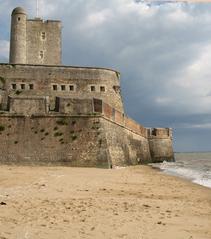Coudepont Battery Visiting Hours, Tickets, and Travel Guide in Île-d’Aix, France
Date: 03/07/2025
Introduction
Nestled on the picturesque Île-d’Aix off France’s Atlantic coast, the Coudepont Battery stands as a testament to the island’s strategic military significance and rich coastal heritage. As part of a network of fortifications developed from the late 17th century, the battery was instrumental in protecting the Rochefort naval arsenal and controlling vital maritime routes at the mouth of the Charente River (Wikipedia). Today, it offers visitors a unique blend of history, panoramic views, and tranquil natural surroundings, making it a top destination for history enthusiasts and travelers exploring Charente-Maritime (Monumentum, Ile d’Aix Office de Tourisme).
This comprehensive guide covers the historical context of the Coudepont Battery, practical visiting information (including hours, ticketing, and transportation), accessibility tips, nearby attractions, and answers to frequently asked questions, ensuring a rewarding and seamless experience on Île-d’Aix.
1. Historical Significance of the Coudepont Battery
Early Strategic Importance
Île-d’Aix’s location at the mouth of the Charente River made it a linchpin in France’s coastal defense system. Fortification efforts began in 1666, coinciding with the establishment of the Rochefort Arsenal (Wikipedia). The Coudepont Battery, situated on the island’s eastern tip, was designed to oversee and defend vital sea approaches and to protect the arsenal from British incursions.
Construction and Evolution
The Coudepont Battery’s origins date back to the late 17th century, with construction reflecting the influence of renowned engineers such as Vauban and François Ferry (Wikipedia). Over the centuries, the battery was upgraded in response to advances in artillery and the evolving nature of naval warfare. Its robust stone walls, gun emplacements, and strategic positioning exemplify the military ingenuity of the era (Monumentum).
Napoleonic and Modern Context
The battery gained further prominence during the Napoleonic era, particularly after Napoleon’s 1808 visit and the 1809 Battle of the Basque Roads, which underscored the need for reinforced coastal defenses (Mary Anne’s France). The site’s layered history is also marked by its role in housing prisoners during the Crimean War and its enduring presence as a symbol of the island’s resilience.
2. Visiting Information: Hours, Tickets, and Access
Opening Hours and Admission
The Coudepont Battery is an open-air historical monument, accessible year-round during daylight hours (generally from 9:00 AM until sunset). There is no entrance fee or ticket required to visit the battery, making it an ideal stop for independent explorers and families alike (Monumentum). Some areas may be restricted for preservation; always respect signage and barriers.
For special events (such as the European Heritage Days in September) or guided tours, check with the Île d’Aix Office de Tourisme for up-to-date information (Tuyo.fr).
Getting to Île-d’Aix
Île-d’Aix is accessible exclusively by ferry, as private vehicles are generally not permitted on the island (Liaison Maritime Fouras–Aix). Main ferry departures run from Fouras-les-Bains (Pointe de la Fumée) year-round, with seasonal connections from La Rochelle, Boyardville, and Saint-Martin-de-Ré (Iles du Ponant). Ferry crossings typically take 20–25 minutes, and tickets can be purchased online or at the terminal. Advance booking is recommended during peak periods, and schedules may vary with tides and weather.
On the Island
Upon arrival, the Coudepont Battery is approximately a 20–30 minute walk or a 10–15 minute bicycle ride from the port. Bike rentals and horse-drawn carriage tours are available near the village (Salt in Our Hair).
3. Site Features and Visitor Experience
- Architecture: The battery features a rectangular plan, thick stone walls, gun emplacements, and remnants of defensive elements such as meurtrières (loopholes) and bretèches. Some interior areas are not open to the public.
- Scenic Views: Located on ocean-facing cliffs, the battery offers sweeping views of the Atlantic and nearby islands, making it a prime spot for photography and quiet reflection (Tuyo.fr).
- Natural Setting: The surrounding environment is rugged and windswept, with shell-strewn beaches and rocky outcrops nearby (Plages.tv). Swimming is not recommended due to strong currents and rocks.
4. Accessibility and Practical Tips
- Terrain: Access is via unpaved walking and cycling paths; the ground is uneven, so the site may be challenging for those with limited mobility.
- Facilities: There are no restrooms, shops, or shelters at the battery. The nearest amenities are in the main village, about 1.5 km away (Iles du Ponant).
- What to Bring: Comfortable shoes, water, sun protection, and a camera. As the island is car-free and has no ATMs, bring sufficient cash and supplies.
- Safety: Stay on marked trails and supervise children near cliffs.
5. Nearby Attractions and Activities
- Fort Liédot: A major 19th-century fortification open for guided tours (Ile d’Aix Office de Tourisme).
- Napoleon Museum: Located in Napoleon’s former residence, this museum provides insight into his final days in France (Guide Charente Maritime).
- Beaches: Plage de l’Anse de la Croix (supervised in summer) and other shell-strewn beaches for relaxation and scenery (Sandee).
- Cycling & Hiking: Well-marked trails make it easy to explore the island’s natural and historical sites.
- Cultural Events: Look for European Heritage Days and seasonal heritage walks.
6. Frequently Asked Questions (FAQ)
Q: What are the visiting hours for Coudepont Battery?
A: The site is accessible during daylight hours year-round. No tickets or reservations are required.
Q: How do I get to Île-d’Aix?
A: By ferry from Fouras-les-Bains (year-round) or seasonally from La Rochelle, Boyardville, and Saint-Martin-de-Ré. Book in advance during summer.
Q: Are guided tours available?
A: The battery is included in some heritage walks and themed tours organized by the tourism office, especially during peak season.
Q: Is the site accessible for people with limited mobility?
A: Access involves uneven, unpaved paths; the battery may not be suitable for visitors with mobility challenges.
Q: Are there amenities at the Coudepont Battery?
A: No; amenities are available in the main village.
7. Visitor Recommendations and Planning Tips
- Plan ahead: Check ferry schedules and book tickets in advance, especially in high season (Liaison Maritime Fouras–Aix).
- Pack appropriately: Bring cash, as there are no ATMs; wear suitable clothing for walking and changing weather.
- Respect the environment: Stay on paths, avoid disturbing wildlife, and take your litter with you (Guide Charente Maritime).
- Enhance your visit: Download the Audiala app for audio guides, real-time ferry info, and interactive content on Île-d’Aix’s historical sites.
8. Conclusion
The Coudepont Battery is a highlight of Île-d’Aix—a remarkable site that weaves together France’s coastal defense history with the island’s unspoiled natural beauty. Free to visit and easily accessible, it is perfect for history lovers, families, and photographers alike. Pair your visit with other attractions such as Fort Liédot, the Napoleon Museum, and the island’s scenic beaches for a full and enriching experience. For the best trip, consult official tourism resources and take advantage of modern tools like the Audiala app to make the most of your journey.
Sources and Further Reading
- Fortifications d’Île d’Aix, Wikipedia, 2024
- Charming Île d’Aix off the French Atlantic Coast, Mary Anne’s France, 2024
- Île d’Aix Batterie de Coudepont, Monumentum, 2024
- Île d’Aix Official Tourism, 2024
- Liaison Maritime Fouras–Aix, Ferry Information, 2024
- Guide Charente Maritime: Discover the Isle of Aix, 2024
- Sandee: Plage de Coudepont, Île d’Aix, 2024


